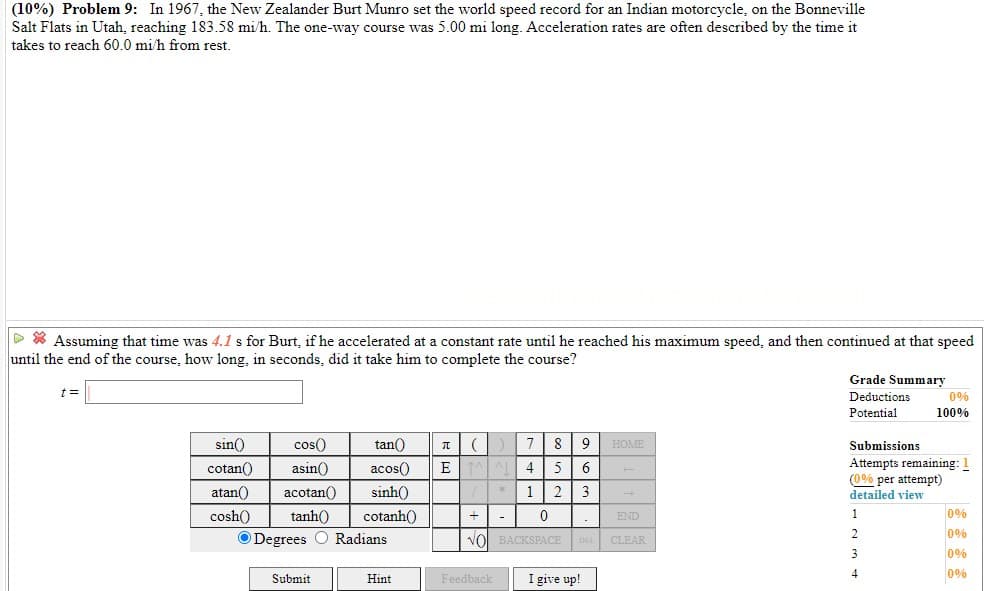(10%) Problem 9: In 1967, the New Zealander Burt Munro set the world speed record for an Indian motorcycle, on the Bonneville Salt Flats in Utah, reaching 183.58 mi/h. The one-way course was 5.00 mi long. Acceleration rates are often described by the time it takes to reach 60.0 mi/h from rest. > * Assuming that time was 4.1 s for Burt, if he accelerated at a constant rate until he reached his maximum speed, and then continued at that speed until the end of the course, how long, in seconds, did it take him to complete the course? Grade Summary Deductions 0%
(10%) Problem 9: In 1967, the New Zealander Burt Munro set the world speed record for an Indian motorcycle, on the Bonneville Salt Flats in Utah, reaching 183.58 mi/h. The one-way course was 5.00 mi long. Acceleration rates are often described by the time it takes to reach 60.0 mi/h from rest. > * Assuming that time was 4.1 s for Burt, if he accelerated at a constant rate until he reached his maximum speed, and then continued at that speed until the end of the course, how long, in seconds, did it take him to complete the course? Grade Summary Deductions 0%
University Physics Volume 1
18th Edition
ISBN:9781938168277
Author:William Moebs, Samuel J. Ling, Jeff Sanny
Publisher:William Moebs, Samuel J. Ling, Jeff Sanny
Chapter3: Motion Along A Straight Line
Section: Chapter Questions
Problem 115CP: In 1967, New Zealander Burt Munro set the world record for an Indian motorcycle, on the Bonneville...
Related questions
Question

Transcribed Image Text:(10%) Problem 9: In 1967, the New Zealander Burt Munro set the world speed record for an Indian motorcycle, on the Bonneville
Salt Flats in Utah, reaching 183.58 mi/h. The one-way course was 5.00 mi long. Acceleration rates are often described by the time it
takes to reach 60.0 mi/h from rest.
> * Assuming that time was 4.1 s for Burt, if he accelerated at a constant rate until he reached his maximum speed, and then continued at that speed
until the end of the course, how long, in seconds, did it take him to complete the course?
Grade Summary
Deductions
0%
Expert Solution
This question has been solved!
Explore an expertly crafted, step-by-step solution for a thorough understanding of key concepts.
This is a popular solution!
Trending now
This is a popular solution!
Step by step
Solved in 3 steps with 4 images

Knowledge Booster
Learn more about
Need a deep-dive on the concept behind this application? Look no further. Learn more about this topic, physics and related others by exploring similar questions and additional content below.Recommended textbooks for you

University Physics Volume 1
Physics
ISBN:
9781938168277
Author:
William Moebs, Samuel J. Ling, Jeff Sanny
Publisher:
OpenStax - Rice University

College Physics
Physics
ISBN:
9781938168000
Author:
Paul Peter Urone, Roger Hinrichs
Publisher:
OpenStax College

College Physics
Physics
ISBN:
9781285737027
Author:
Raymond A. Serway, Chris Vuille
Publisher:
Cengage Learning

University Physics Volume 1
Physics
ISBN:
9781938168277
Author:
William Moebs, Samuel J. Ling, Jeff Sanny
Publisher:
OpenStax - Rice University

College Physics
Physics
ISBN:
9781938168000
Author:
Paul Peter Urone, Roger Hinrichs
Publisher:
OpenStax College

College Physics
Physics
ISBN:
9781285737027
Author:
Raymond A. Serway, Chris Vuille
Publisher:
Cengage Learning

An Introduction to Physical Science
Physics
ISBN:
9781305079137
Author:
James Shipman, Jerry D. Wilson, Charles A. Higgins, Omar Torres
Publisher:
Cengage Learning